我们几乎可以在任何操作系统上通过命令行指令与操作系统进行交互,比如Linux平台下的 shell 。那么我们如何通过Python来完成这些命令行指令的执行呢?另外,我们应该知道的是命令行指令的执行通常有两个我们比较关注的结果:
命令执行的状态码–表示命令执行是否成功
命令执行的输出结果–命令执行成功后的输出
早期的Python版本中,我们主要是通过os.system()、os.popen().read()等函数来执行命令行指令的,另外还有一个很少使用的commands模块。但是从Python 2.4开始官方文档中建议使用的是subprocess模块,所以os模块和commands模块的相关函数在这里只提供一个简单的使用示例,我们重要要介绍的是subprocess模块。
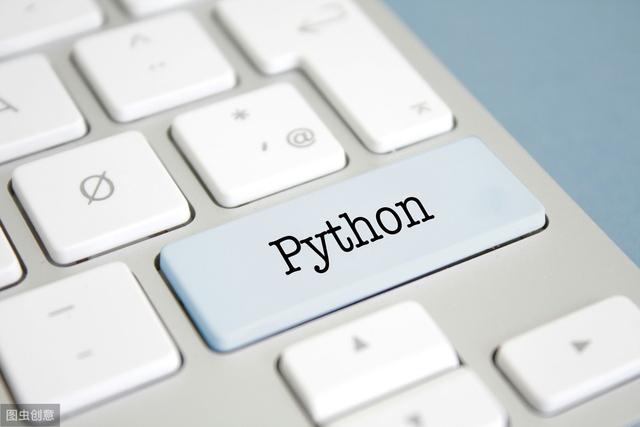
一、os与commands模块
Python中提供了以下几个函数来帮助我们完成命令行指令的执行:
os.system(cmd): 返回命令执行状态码,而将命令执行结果输出到屏幕
os.popen(command).read(): 可以获取命令执行结果,但是无法获取命令执行状态码
commands.getstatusoutput(command):返回一个元组(命令执行状态码, 命令执行结果)
说明:
- os.popen(command)函数得到的是一个文件对象,因此除了read()方法外还支持write()等方法,具体要根据command来定;
- commands模块只存在于Python 2.7中,且不支持windows平台,因此commands模块很少被使用。另外,commands模块实际上也是通过对os.popen()的封装来完成的。
1. os.system()函数实例
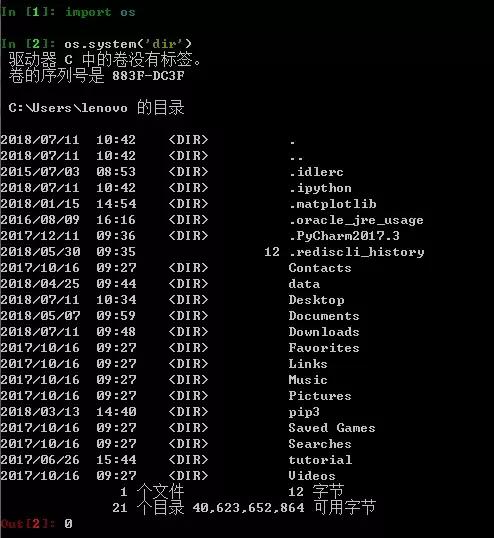
2. os.popen()函数实例
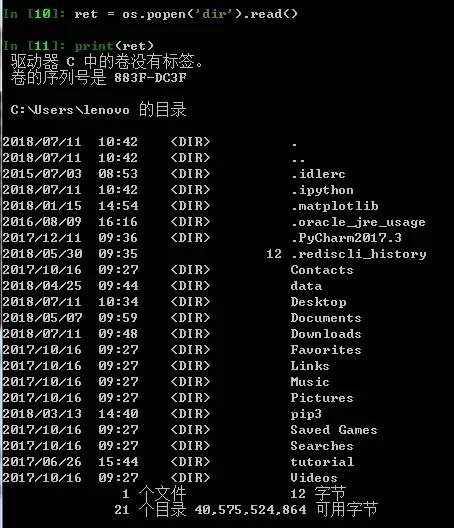
3. commands.getstatusoutput()函数实例
需要注意的是commands模块不支持windows平台,因此该实例是在Linux平台下执行的
>>> import os>>> os.system('ls')cmdline-jmxclient-0.10.3.jar dhparam.pem FtpMan.class gitlab.crt gitlab.csr gitlab.key resolv.txt test.json test.php test.sh test.text test.txt0>>> import commands>>> retcode, ret = commands.getstatusoutput('ls -l')>>> retcode0>>> print(ret)total 68-rw-r--r-- 1 root root 20124 Jul 11 2016 cmdline-jmxclient-0.10.3.jar-rw-r--r-- 1 root root 424 Aug 22 2016 dhparam.pem-rw-r--r-- 1 root root 2576 Jul 13 2016 FtpMan.class-rw-r--r-- 1 root root 1302 Aug 22 2016 gitlab.crt-rw-r--r-- 1 root root 1054 Aug 22 2016 gitlab.csr-rw-r--r-- 1 root root 1675 Aug 22 2016 gitlab.key-rw-r--r-- 1 root root 9329 Jun 24 2016 resolv.txt-rw-r--r-- 1 root root 594 Mar 7 08:14 test.json-rw-r--r-- 1 root root 162 Jun 28 10:39 test.php-rw-r--r-- 1 root root 760 Jun 24 2016 test.sh-r-x------ 1 root root 0 Feb 6 08:21 test.textdrwxr-xr-x 2 root root 4096 Feb 7 16:43 test.txt>>>
通过查看commands模块提供的属性可知,它也提供了单独获取命令执行状态码和执行结果的函数,如下所示:
>>> dir(commands)['__all__', '__builtins__', '__doc__', '__file__', '__name__', '__package__', 'getoutput', 'getstatus', 'getstatusoutput', 'mk2arg', 'mkarg']
二、subprocess模块
subprocess以及常用的封装函数
运行python的时候,我们都是在创建并运行一个进程。像Linux进程那样,一个进程可以fork一个子进程,并让这个子进程exec另外一个程序。在Python中,我们通过标准库中的subprocess包来fork一个子进程,并运行一个外部的程序。
subprocess包中定义有数个创建子进程的函数,这些函数分别以不同的方式创建子进程,所以我们可以根据需要来从中选取一个使用。另外subprocess还提供了一些管理标准流(standard stream)和管道(pipe)的工具,从而在进程间使用文本通信。
1.subprocess模块中的常用函数
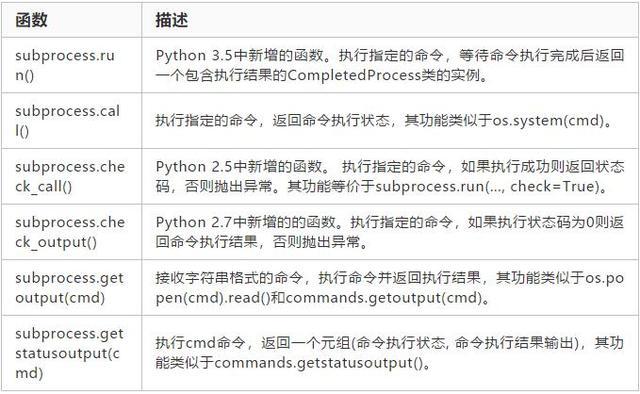
说明:
subprocess.call()
父进程等待子进程完成
返回退出信息(returncode,相当于Linux exit code)
subprocess.check_call()
父进程等待子进程完成
返回0
检查退出信息,如果returncode不为0,则举出错误subprocess.CalledProcessError,该对象包含有returncode属性,可用try…except…来检查
subprocess.check_output()
父进程等待子进程完成
返回子进程向标准输出的输出结果
检查退出信息,如果returncode不为0,则举出错误subprocess.CalledProcessError,该对象包含有returncode属性和output属性,output属性为标准输出的输出结果,
可用try…except…来检查。
这三个函数的使用方法相类似
2. 上面各函数的定义及参数说明
函数参数列表:
subprocess.run(args, *, stdin=None, input=None, stdout=None, stderr=None, shell=False, timeout=None, check=False, universal_newlines=False)subprocess.call(args, *, stdin=None, stdout=None, stderr=None, shell=False, timeout=None)subprocess.check_call(args, *, stdin=None, stdout=None, stderr=None, shell=False, timeout=None)subprocess.check_output(args, *, stdin=None, stderr=None, shell=False, universal_newlines=False, timeout=None)subprocess.getstatusoutput(cmd)subprocess.getoutput(cmd)
参数说明:
args: 要执行的shell命令,默认应该是一个 字符串 序列,如[‘df’, ‘-Th’]或(‘df’, ‘-Th’),也可以是一个字符串,如’df -Th’,但是此时需要把shell参数的值置为True。
shell: 如果shell为True,那么指定的命令将通过shell执行。如果我们需要访问某些shell的特性,如管道、文件名通配符、环境变量扩展功能,这将是非常有用的。当然,python本身也提供了许多类似shell的特性的实现,如glob、fnmatch、os.walk()、os.path.expandvars()、os.expanduser()和shutil等。
check: 如果check参数的值是True,且执行命令的进程以非0状态码退出,则会抛出一个CalledProcessError的异常,且该异常对象会包含 参数、退出状态码、以及stdout和stderr(如果它们有被捕获的话)。
stdout, stderr: run()函数默认不会捕获命令执行结果的正常输出和错误输出,如果我们向获取这些内容需要传递subprocess.PIPE,然后可以通过返回的CompletedProcess类实例的stdout和stderr属性或捕获相应的内容;
call()和check_call()函数返回的是命令执行的状态码,而不是CompletedProcess类实例,所以对于它们而言,stdout和stderr不适合赋值为subprocess.PIPE;
check_output()函数默认就会返回命令执行结果,所以不用设置stdout的值,如果我们希望在结果中捕获错误信息,可以执行stderr=subprocess.STDOUT。
input: 该参数是传递给Popen.communicate(),通常该参数的值必须是一个字节序列,如果universal_newlines=True,则其值应该是一个字符串。
universal_newlines: 该参数影响的是输入与输出的数据格式,比如它的值默认为False,此时stdout和stderr的输出是字节序列;当该参数的值设置为True时,stdout和stderr的输出是字符串。
3. 实例
subprocess.run()
>>> subprocess.run(["ls", "-l"]) # doesn't capture outputCompletedProcess(args=['ls', '-l'], returncode=0)>>> subprocess.run("exit 1", shell=True, check=True)Traceback (most recent call last): ...subprocess.CalledProcessError: Command 'exit 1' returned non-zero exit status 1>>> subprocess.run(["ls", "-l", "/dev/null"], stdout=subprocess.PIPE)CompletedProcess(args=['ls', '-l', '/dev/null'], returncode=0,stdout=b'crw-rw-rw- 1 root root 1, 3 Jan 23 16:23 /dev/null\n')
subprocess.call()
>>> subprocess.call(['ls', '-l'])总用量 160drwxr-xr-x 2 wader wader 4096 12月 7 2015 公共的drwxr-xr-x 2 wader wader 4096 12月 7 2015 模板drwxr-xr-x 2 wader wader 4096 12月 7 2015 视频drwxr-xr-x 2 wader wader 4096 12月 7 2015 图片drwxr-xr-x 2 wader wader 4096 12月 7 2015 文档drwxr-xr-x 2 wader wader 4096 4月 13 2016 下载drwxr-xr-x 2 wader wader 4096 12月 7 2015 音乐drwxr-xr-x 7 wader wader 4096 5月 26 2016 桌面0>>> subprocess.call('ls -l', shell=True)总用量 160drwxr-xr-x 2 wader wader 4096 12月 7 2015 公共的drwxr-xr-x 2 wader wader 4096 12月 7 2015 模板drwxr-xr-x 2 wader wader 4096 12月 7 2015 视频drwxr-xr-x 2 wader wader 4096 12月 7 2015 图片drwxr-xr-x 2 wader wader 4096 12月 7 2015 文档drwxr-xr-x 2 wader wader 4096 4月 13 2016 下载drwxr-xr-x 2 wader wader 4096 12月 7 2015 音乐drwxr-xr-x 7 wader wader 4096 5月 26 2016 桌面0>>> subprocess.call(['ls', '-l'], stdout=subprocess.DEVNULL)0>>> subprocess.call(['ls', '-l', '/test'])ls: 无法访问/test: 没有那个文件或目录2
suprocess.check_call()
>>> subprocess.check_call(['ls', '-l'])总用量 160drwxr-xr-x 2 wader wader 4096 12月 7 2015 公共的drwxr-xr-x 2 wader wader 4096 12月 7 2015 模板drwxr-xr-x 2 wader wader 4096 12月 7 2015 视频drwxr-xr-x 2 wader wader 4096 12月 7 2015 图片drwxr-xr-x 2 wader wader 4096 12月 7 2015 文档drwxr-xr-x 2 wader wader 4096 4月 13 2016 下载drwxr-xr-x 2 wader wader 4096 12月 7 2015 音乐drwxr-xr-x 7 wader wader 4096 5月 26 2016 桌面0>>> subprocess.check_call('ls -l', shell=True)总用量 160drwxr-xr-x 2 wader wader 4096 12月 7 2015 公共的drwxr-xr-x 2 wader wader 4096 12月 7 2015 模板drwxr-xr-x 2 wader wader 4096 12月 7 2015 视频drwxr-xr-x 2 wader wader 4096 12月 7 2015 图片drwxr-xr-x 2 wader wader 4096 12月 7 2015 文档drwxr-xr-x 2 wader wader 4096 4月 13 2016 下载drwxr-xr-x 2 wader wader 4096 12月 7 2015 音乐drwxr-xr-x 7 wader wader 4096 5月 26 2016 桌面0>>> subprocess.check_call('ls -l /test', shell=True)ls: 无法访问/test: 没有那个文件或目录Traceback (most recent call last): File "<stdin>", line 1, in <module> File "/usr/lib/python3.4/subprocess.py", line 557, in check_call raise CalledProcessError(retcode, cmd)subprocess.CalledProcessError: Command 'ls -l /test' returned non-zero exit status 2
sbuprocess.check_output()
>>> ret = subprocess.check_output(['ls', '-l'])>>> print(ret)b' \xe5\x85\xac\xe5\x85\xb1\xe7\x9a\x84\ndrwxr-xr-x 2 wader wader 4096 12\xe6\x9c\x88 7 2015 \xe6\xa8\xa1\xe6\x9d\xbf\ndrwxr-xr-x 2 wader wader 4096 12\xe6\x9c\x88 7 2015 \xe8\xa7\x86\xe9\xa2\x91\ndrwxr-xr-x 2 wader wader 4096 12\xe6\x9c\x88 7 2015 \xe5\x9b\xbe\xe7\x89\x87\ndrwxr-xr-x 2 wader wader 4096 12\xe6\x9c\x88 7 2015 \xe6\x96\x87\xe6\xa1\xa3\ndrwxr-xr-x 2 wader wader 4096 4\xe6\x9c\x88 13 2016 \xe4\xb8\x8b\xe8\xbd\xbd\ndrwxr-xr-x 2 wader wader 4096 12\xe6\x9c\x88 7 2015 \xe9\x9f\xb3\xe4\xb9\x90\ndrwxr-xr-x 7 wader wader 4096 5\xe6\x9c\x88 26 2016 \xe6\xa1\x8c\xe9\x9d\xa2\n'>>> ret = subprocess.check_output(['ls', '-l'], universal_newlines=True)>>> print(ret)总用量 160drwxr-xr-x 2 wader wader 4096 12月 7 2015 公共的drwxr-xr-x 2 wader wader 4096 12月 7 2015 模板drwxr-xr-x 2 wader wader 4096 12月 7 2015 视频drwxr-xr-x 2 wader wader 4096 12月 7 2015 图片drwxr-xr-x 2 wader wader 4096 12月 7 2015 文档drwxr-xr-x 2 wader wader 4096 4月 13 2016 下载drwxr-xr-x 2 wader wader 4096 12月 7 2015 音乐drwxr-xr-x 7 wader wader 4096 5月 26 2016 桌面
subprocess.getoutput()与subprocess.getstatusoutput()
>>> ret = subprocess.getoutput('ls -l')>>> print(ret)总用量 160drwxr-xr-x 2 wader wader 4096 12月 7 2015 公共的drwxr-xr-x 2 wader wader 4096 12月 7 2015 模板drwxr-xr-x 2 wader wader 4096 12月 7 2015 视频drwxr-xr-x 2 wader wader 4096 12月 7 2015 图片drwxr-xr-x 2 wader wader 4096 12月 7 2015 文档drwxr-xr-x 2 wader wader 4096 4月 13 2016 下载drwxr-xr-x 2 wader wader 4096 12月 7 2015 音乐drwxr-xr-x 7 wader wader 4096 5月 26 2016 桌面>>> retcode, output = subprocess.getstatusoutput('ls -l')>>> print(retcode)0>>> print(output)总用量 160drwxr-xr-x 2 wader wader 4096 12月 7 2015 公共的drwxr-xr-x 2 wader wader 4096 12月 7 2015 模板drwxr-xr-x 2 wader wader 4096 12月 7 2015 视频drwxr-xr-x 2 wader wader 4096 12月 7 2015 图片drwxr-xr-x 2 wader wader 4096 12月 7 2015 文档drwxr-xr-x 2 wader wader 4096 4月 13 2016 下载drwxr-xr-x 2 wader wader 4096 12月 7 2015 音乐drwxr-xr-x 7 wader wader 4096 5月 26 2016 桌面>>> retcode, output = subprocess.getstatusoutput('ls -l /test')>>> print(retcode)2>>> print(output)ls: 无法访问/test: 没有那个文件或目录
三、subprocess.Popen介绍
该类用于在一个新的进程中执行一个子程序。前面我们提到过,上面介绍的这些函数都是基于subprocess.Popen类实现的,通过使用这些被封装后的高级函数可以很方面的完成一些常见的需求。由于subprocess模块底层的进程创建和管理是由Popen类来处理的,因此,当我们无法通过上面哪些高级函数来实现一些不太常见的功能时就可以通过subprocess.Popen类提供的灵活的api来完成。
1.subprocess.Popen的构造函数
class subprocess.Popen(args, bufsize=-1, executable=None, stdin=None, stdout=None, stderr=None, preexec_fn=None, close_fds=True, shell=False, cwd=None, env=None, universal_newlines=False, startup_info=None, creationflags=0, restore_signals=True, start_new_session=False, pass_fds=())
参数说明:
args: 要执行的shell命令,可以是字符串,也可以是命令各个参数组成的序列。当该参数的值是一个字符串时,该命令的解释过程是与平台相关的,因此通常建议将args参数作为一个序列传递。
bufsize: 指定缓存策略,0表示不缓冲,1表示行缓冲,其他大于1的数字表示缓冲区大小,负数 表示使用系统默认缓冲策略。
stdin, stdout, stderr: 分别表示程序标准输入、输出、错误句柄。
preexec_fn: 用于指定一个将在子进程运行之前被调用的可执行对象,只在Unix平台下有效。
close_fds: 如果该参数的值为True,则除了0,1和2之外的所有文件描述符都将会在子进程执行之前被关闭。
shell: 该参数用于标识是否使用shell作为要执行的程序,如果shell值为True,则建议将args参数作为一个字符串传递而不要作为一个序列传递。
cwd: 如果该参数值不是None,则该函数将会在执行这个子进程之前改变当前工作目录。
env: 用于指定子进程的环境变量,如果env=None,那么子进程的环境变量将从父进程中继承。如果env!=None,它的值必须是一个映射对象。
universal_newlines: 如果该参数值为True,则该文件对象的stdin,stdout和stderr将会作为文本流被打开,否则他们将会被作为二进制流被打开。
startupinfo和creationflags: 这两个参数只在Windows下有效,它们将被传递给底层的CreateProcess()函数,用于设置子进程的一些属性,如主窗口的外观,进程优先级等。
Popen对象创建后,主程序不会自动等待子进程完成。我们必须调用对象的wait()方法,父进程才会等待 (也就是阻塞block),举例:
代码如下:
>>> import subprocess>>> child = subprocess.Popen(['ping','-n','4','www.baidu.com'])>>> print ('parent process')
从运行结果中看到,父进程在开启子进程之后并没有等待child的完成,而是直接运行print。
对比等待的情况:
代码如下:
>>> import subprocess>>> child = subprocess.Popen('ping -n 4 www.baidu.com',shell=True)>>> child.wait()>>> print ('parent process')
从运行结果中看到,父进程在开启子进程之后并等待child的完成后,再运行print。
2. subprocess.Popen类的实例可调用的方法
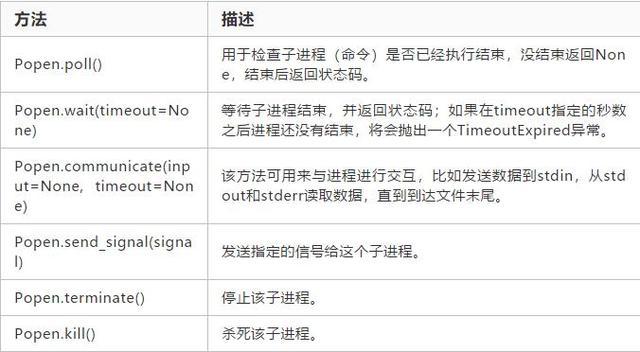
你可以在父进程中对子进程进行其它操作,比如我们上面例子中的child对象,代码如下:
child.poll() # 检查子进程状态child.kill() # 终止子进程child.send_signal() # 向子进程发送信号child.terminate() # 终止子进程
子进程的PID存储在child.pid
关于communicate()方法的说明:
该方法中的可选参数 input 应该是将被发送给子进程的数据,或者如没有数据发送给子进程,该参数应该是None。input参数的数据类型必须是字节串,如果universal_newlines参数值为True,则input参数的数据类型必须是字符串。
该方法返回一个元组(stdout_data, stderr_data),这些数据将会是字节穿或字符串(如果universal_newlines的值为True)。
如果在timeout指定的秒数后该进程还没有结束,将会抛出一个TimeoutExpired异常。捕获这个异常,然后重新尝试通信不会丢失任何输出的数据。但是超时之后子进程并没有被杀死,为了合理的清除相应的内容,一个好的应用应该手动杀死这个子进程来结束通信。
需要注意的是,这里读取的数据是缓冲在内存中的,所以,如果数据大小非常大或者是无限的,就不应该使用这个方法。
communicate()是Popen对象的一个方法,该方法会阻塞父进程,直到子进程完成
3. subprocess.Popen使用实例
实例1:
>>> import subprocess>>>>>> p = subprocess.Popen('df -Th', stdout=subprocess.PIPE, shell=True)>>> print(p.stdout.read())Filesystem Type Size Used Avail Use% Mounted on/dev/vda1 ext4 40G 12G 26G 31% /devtmpfs devtmpfs 3.9G 0 3.9G 0% /devtmpfs tmpfs 3.9G 0 3.9G 0% /dev/shmtmpfs tmpfs 3.9G 386M 3.5G 10% /runtmpfs tmpfs 3.9G 0 3.9G 0% /sys/fs/cgrouptmpfs tmpfs 783M 0 783M 0% /run/user/0tmpfs tmpfs 783M 0 783M 0% /run/user/1000
实例2:
>>> obj = subprocess.Popen(["python"], stdin=subprocess.PIPE, stdout=subprocess.PIPE, stderr=subprocess.PIPE)>>> obj.stdin.write('print(1) \n')>>> obj.stdin.write('print(2) \n')>>> obj.stdin.write('print(3) \n')>>> out,err = obj.communicate()>>> print(out)123>>> print(err)
实例3:
>>> obj = subprocess.Popen(["python"], stdin=subprocess.PIPE, stdout=subprocess.PIPE, stderr=subprocess.PIPE)>>> out,err = obj.communicate(input='print(1) \n')>>> print(out)1>>> print(err)
实例4:
实现类似df -Th | grep data命令的功能,实际上就是实现shell中管道的功能。
>>> >>> p1 = subprocess.Popen(['df', '-Th'], stdout=subprocess.PIPE)>>> p2 = subprocess.Popen(['grep', 'data'], stdin=p1.stdout, stdout=subprocess.PIPE)>>> out,err = p2.communicate()>>> print(out)/dev/vdb1 ext4 493G 4.8G 463G 2% /data/dev/vdd1 ext4 1008G 420G 537G 44% /data1/dev/vde1 ext4 985G 503G 432G 54% /data2>>> print(err)None
subprocess.PIPE实际上为文本流提供一个缓存区。p1的stdout将文本输出到缓存区,随后p2的stdin从该PIPE中将文本读取走。p2的输出文本也被存放在PIPE中,直到communicate()方法从PIPE中读取出PIPE中的文本。
四、总结
那么我们到底该用哪个模块、哪个函数来执行命令与系统及系统进行交互呢?下面我们来做个总结:
首先应该知道的是,Python2.4版本引入了subprocess模块用来替换os.system()、os.popen()、os.spawn*()等函数以及commands模块;也就是说如果你使用的是Python 2.4及以上的版本就应该使用subprocess模块了。
如果你的应用使用的Python 2.4以上,但是是Python 3.5以下的版本,Python官方给出的建议是使用subprocess.call()函数。Python 2.5中新增了一个subprocess.check_call()函数,Python 2.7中新增了一个subprocess.check_output()函数,这两个函数也可以按照需求进行使用。
如果你的应用使用的是Python 3.5及以上的版本(目前应该还很少),Python官方给出的建议是尽量使用subprocess.run()函数。
当subprocess.call()、subprocess.check_call()、subprocess.check_output()和subprocess.run()这些高级函数无法满足需求时,我们可以使用subprocess.Popen类来实现我们需要的复杂功能。
来源网络,侵权删除


